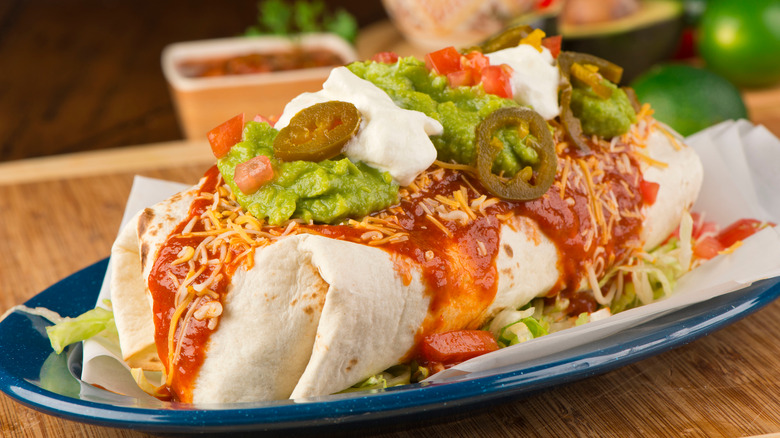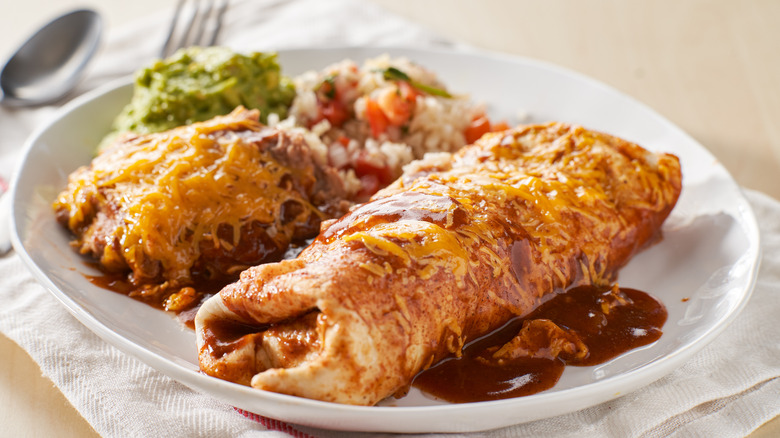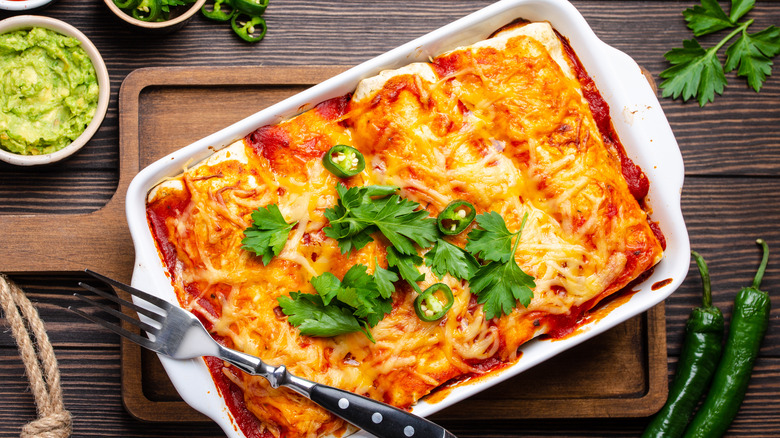Here's What Makes 'Wet Burritos' Unique
We all know that Taco Tuesday is the best day of the week, but Wet Burrito Wednesday may be seriously underrated.
Chimichangas, street tacos, chili con carne, burritos — many Americans view these classic foods as authentic Mexican dishes. But, compared to popular belief, these foods actually fall under the Tex-Mex category, which has evolved into its own cuisine since the 1970s. According to Serious Eats, "Tex-Mex" stems from the Tejano people, or Texan residents of Spanish or Mexican descent. It is a portmanteau of "Texan" and "Mexican" and was coined as its own cuisine by Diana Kennedy in her 1972 cookbook "Cuisines of Mexico," according to History.com.
Since then, Tex-Mex has become one of the largest food categories in America, with restaurants like Taco Bell, Del Taco, and Chipotle at the forefront of the scene. These restaurants are mostly known for their crunchy tacos, burrito bowls, and quesadillas, some of the most common and popular Tex-Mex items. But Tijuana Flats, recognized for its personalized murals and unusual sauces, is also known for its monstrous burritos. Served with a generous side of salted tortilla chips, these burritos can be made wet with chipotle, queso, or queso-Blanco sauce. But what makes this different from a regular burrito, and why is it unique?
The Wet Burrito: An innovative solution to an ordinary problem
Some of the best inventions come from the simplest mistakes, and the wet burrito is no exception.
According to ABC 13, this burrito was first created in 1966 at the Beltline Bar in Grand Rapids, Michigan, when the Tex-Mex restaurant mistakenly received an order of too-large tortillas. With the owner out of town, the manager decided to run a special that featured an unordinary burrito. It was essentially flipped inside out, with seasoned ground beef, refried beans, and vegetables wrapped inside a flour tortilla, slathered in a bed of melted cheese and enchilada sauce. It also required a fork and knife rather than two hands, which went against the traditional burrito's transportable nature. By the time the owner returned, the Tex-Mex industry had changed, all thanks to the wet burrito.
As of 2018, the Famous Wet Burrito has been enjoyed and celebrated more than 5 million times, per Michigan Live. It was even visited by Casey Webb, host of the Travel Channel's "Man v. Food" for the Season 2 finale. Though the burrito was only featured for a short time, the Beltline Bar still celebrated the national recognition of their crafty food.
Jeff Lobdell, the current owner of the Beltline Bar, told Michigan Live, "The day we spent with Casey Webb and his crew was so much fun ... Beltline Bar is honored to be part of a show that spotlights our historic restaurant and the city of Grand Rapids."
Enchilada vs. Wet Burrito
If you take a flour tortilla and fill it with meat and vegetables, then cover it with melted cheese and red sauce and use cutlery to eat it, what does that make it? An enchilada or a burrito?
According to Guadalajara's Grill, the Mayans first enjoyed enchiladas with tlaxcalli, or corn tortillas, that were hollow inside and dipped in a spiced sauce. Eventually, ground meat and cheese began to fill these empty shells that were then baked with extra cheese and sauce on top. Although the enchilada has changed over the centuries, one thing remained: they were rolled into cylinders with open ends.
On the other hand, burritos are made from flour tortillas and are theorized to have been invented in the 1900s, though their history remains unclear. Vox reports that burritos were allegedly created in Sonora, Mexico, for their portability and convenience and stemmed from the word "burro," or a small donkey.
As we all know and love, burritos are sealed on both sides and contain a meat and cheese filling. The wet burrito only adds to this with an extra layer of enchilada sauce and cheese on top. These fundamental differences — corn vs. flour, open ends vs. sealed — separate enchiladas from wet burritos. But beware: they may also go by smothered burritos or enchilada-style burritos, per Serious Eats. So, next time you visit your local Tex-Mex restaurant, check for flour tortillas with folded ends to ensure an authentic wet burrito experience.


